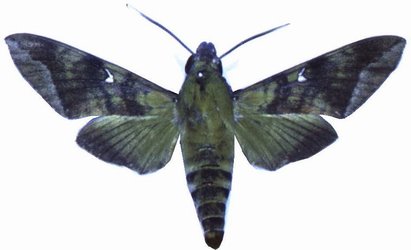Nephele comma (Comma
nephele hawkmoth)
Life
> Eukaryotes >
Opisthokonta
>
Metazoa (animals) > Bilateria >
Ecdysozoa > Panarthropoda > Tritocerebra > Phylum:
Arthopoda > Mandibulata >
Atelocerata > Panhexapoda >
Hexapoda
> Insecta (insects) > Dicondyla > Pterygota >
Metapterygota > Neoptera > Eumetabola > Holometabola > Panorpida >
Amphiesmenoptera > Lepidoptera (moths and butterflies)
> Glossata > Coelolepida > Myoglossata > Neolepidoptera > Heteroneura >
Ditrysia > Apoditrysia > Obtectomera >
Macrolepidoptera > Bombycoidea > Family:
Sphingidae (hawkmoths) > Subfamily: Macroglossinae > Genus:
Nephele

Nephele comma male [photo J. Joannou ©]
Distribution
Throughout Africa south of the Sahara as well as adjacent
islands (Pinhey 1975).
Ecological interactions
Larval host plants in southern Africa
Recorded in
Kroon (1999).
Pollination
Pollinates a variety of long-tubed flowers
including:
-
Caricaceae
-
Carica papaya (Papaya, Papaw, Pawpaw). A cultivated species,
pollinated by hawkmoths, including Nephele comma. Martins & Johnson
(2009) in a study conducted in rural Kenya, found that natural habitats were
important in sustaining hawkmoth populations because they contained the
larval hostplants needed in completing the life cycle. Hence, papaya plants
grown near natural habitats were more likely to be pollinated than those
isolated from natural habitats.
Publications (by date)
-
Pinhey, E.C.G. 1975. Moths of Southern
Africa. Tafelberg, Cape Town.
-
Kroon, D.M. 1999. Lepidoptera of Southern
Africa - Host-plants and other Associations. A Catalogue. Published by
the author and Lepidopterists' Society of Africa, P.O. Box 477, Jukskei Park
2153, South Africa.
-
Martins DJ, Johnson SD. 2009. Distance and quality of
natural habitat influence hawkmoth pollination of cultivated papaya.
International Journal of Tropical Insect Science 29: 114-123.
http://dx.doi.org/10.1017/S1742758409990208
|
